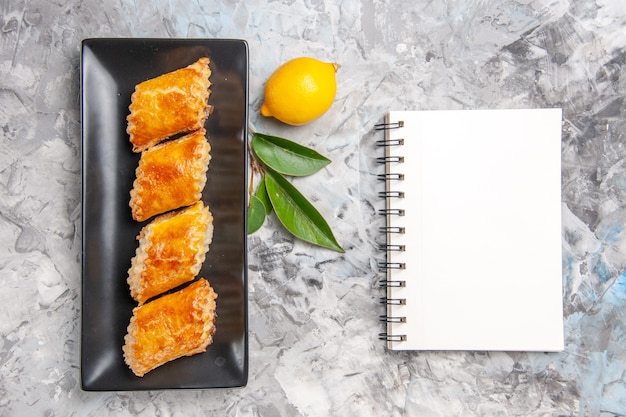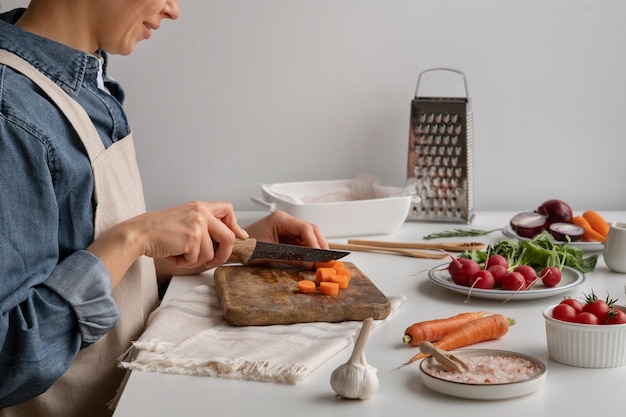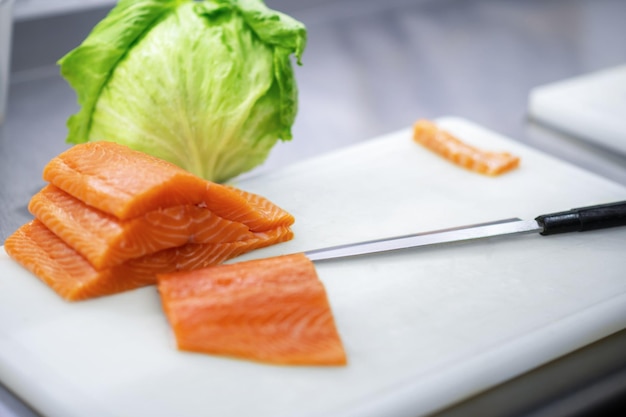Let's talk salmon, shall we? It's a fish that's always welcome on my dinner table, and I bet it's a favourite in your kitchen too. It's versatile, healthy, and, well, utterly delicious. But like any ingredient worth its salt, getting the most out of this lovely fish takes a bit of know-how. So, grab a fork and join me on this journey through salmon, from the basics to some more adventurous dishes. We'll cover everything from choosing the right fish to perfecting your cooking techniques, and we'll even throw in some seriously tasty recipes along the way. Buckle up, it's going to be a delicious ride.
Part 1: Choosing the perfect salmon

The Great Salmon Debate: Wild vs. Farmed
The first stop on our salmon journey is deciding which type of fish is right for you. It all boils down to two main options: wild and farmed. Now, I'm a big fan of both, but if we're being honest, the flavour of wild salmon is truly something else. It's got this depth of flavour, a real taste of the ocean, that's just hard to beat. The downside? Well, it tends to be a bit pricier. farmed salmon, on the other hand, is generally more affordable and readily available. However, the key here is to choose sustainably farmed salmon. Look for labels like ASC or MSC, which means the fish has been raised in an environmentally responsible way.
types of salmon: A Culinary Road Trip
Once you’ve chosen your camp – wild or farmed – it’s time to delve into the world of salmon varieties. The most common is atlantic salmon, a real workhorse in the kitchen with a rich flavour and a good amount of fat. Then, we’ve got pacific salmon, which is a whole other adventure in itself. Think Chinook, Sockeye, Coho, and Pink, each with its own unique personality. Chinook, often called the king salmon, is bold and buttery, while Sockeye has a delicate flavour and a gorgeous red colour. Coho is known for its mild, almost sweet taste, and Pink, well, it's a more budget-friendly option.
The Salmon Test: A Guide to Choosing the Best Fish
Now you're at the fishmonger, ready to choose your salmon. But how do you pick the best piece? First, give it the "firmness test" – the flesh should be springy, not mushy. Second, check the gills – they should be a vibrant red, not pale or brown. Finally, take a whiff. A fresh fish will smell like the sea, not fishy or ammonia-like.
Part 2: salmon preparation 101

The Art of Skinning a Salmon
Alright, you've got your salmon, but before we get to the good stuff – cooking it – you need to skin it. Don't worry, it's easier than it looks. A sharp knife is your best friend. Simply slide the knife along the skin, and, voila, you're left with a beautifully skinned fillet. If you're feeling adventurous, you can leave the skin on for a bit of extra flavour and crispiness. Just be sure to score it diagonally to help it cook evenly.
Slicing and Dicing: The Perfect Salmon Portions
Now that your salmon is skinned, it’s time to portion it. If you’re a seasoned chef, you probably already know exactly how thick or thin you want it. But for the rest of us, here's the rule of thumb. Think about your cooking method. For pan-frying or grilling, you want fillets about 1-1.5 inches thick. For baking or roasting, you can go a bit thicker, around 2 inches. If you're aiming for individual portions, simply cut those fillets into smaller pieces.
Seasoning: The Key to Flavour
Your salmon is ready for the magic touch: seasoning. This is your chance to really get creative. Simple salt and pepper is a classic, but I like to add a little zest of lemon, or perhaps some dried herbs like thyme or rosemary. For a touch of heat, try a sprinkle of chili flakes or a dash of paprika. Just remember, the goal is to enhance the salmon's natural flavour, not drown it out.
Part 3: cooking salmon with Confidence

Pan-Frying: The Classic Approach
Pan-frying is probably the most common way to cook salmon. It's quick, easy, and creates a beautiful golden crust. First, heat a generous amount of oil in a pan over medium-high heat. Then, carefully place your seasoned salmon fillets in the pan, skin-side down. Don't overcrowd the pan – if you have a lot of fillets, cook them in batches. After about 3-4 minutes, flip the fillets over and cook for another 2-3 minutes, or until they're cooked through. The internal temperature should reach 145°F (63°C).
Grilling: Bringing the Outdoor Flavour
There's something about grilled salmon that just screams summer. For a perfectly grilled salmon, you need a hot grill, preheated to medium-high heat. Oil the grill grates to prevent sticking, and then place your salmon fillets on the grill, skin-side down. Close the lid and let it cook for about 4-5 minutes. Then, flip the fillets over and cook for another 3-4 minutes, or until cooked through. You can even grill salmon whole, which is perfect for feeding a crowd.
Baking: Easy and Effortless
If you're looking for a hands-off method, baking is your best friend. Preheat your oven to 400°F (200°C). Place your salmon fillets on a baking sheet lined with parchment paper. Drizzle them with a little olive oil, season to your liking, and pop them in the oven. They'll be ready in about 12-15 minutes, or until cooked through.
Roasting: Adding Depth of Flavour
Roasting salmon is another fantastic way to create a flavour-packed dish. Preheat your oven to 375°F (190°C). Place your salmon fillets in a roasting pan. Feel free to add vegetables, herbs, and even citrus fruits around the salmon for extra flavour. Cover the pan with foil and roast for about 15-20 minutes, or until the salmon is cooked through.
Part 4: The Art of Salmon Sauces
Lemon Butter Sauce: A Classic Pairing
Nothing beats a simple lemon butter sauce for salmon. It's tangy, rich, and the perfect complement to the fish. Just melt some butter in a pan over low heat. Squeeze in some lemon juice, whisk in some chopped fresh parsley, and pour the sauce over your cooked salmon. It's simplicity at its finest.
Creamy Dill Sauce: A Scandinavian Delight
For a creamy and aromatic sauce, try a dill sauce. Whisk together some sour cream, mayonnaise, chopped fresh dill, lemon juice, and salt and pepper. Spoon this sauce over your salmon and enjoy a taste of Scandinavia.
Spicy Mango Salsa: A Tropical Twist
If you're feeling adventurous, try a spicy mango salsa. Combine diced mango, red onion, jalapeno peppers, cilantro, lime juice, and salt and pepper. Top your grilled or pan-fried salmon with this vibrant salsa for a flavour explosion that transports you to the tropics.
Teriyaki Glaze: An Asian-Inspired Delight
For an umami-rich glaze, try teriyaki. Combine soy sauce, mirin, sugar, and ginger in a saucepan and simmer until thickened. Baste your salmon fillets with this glaze while they cook for a sweet and savory finish that's a nod to Asian cuisine.
Part 5: Salmon Sides: A Culinary Symphony
Roasted Vegetables: A Rainbow of Flavour
Roasted vegetables are a perfect companion for salmon. Think asparagus, broccoli, carrots, Brussels sprouts, and sweet potatoes. Toss them with olive oil, salt, pepper, and your favourite herbs and roast them in the oven alongside your salmon. The vegetables will soak up the salmon’s flavour, and the salmon will be enhanced by the roasted aroma, creating a symphony of taste.
Green Salad: A Refreshing Counterpoint
A simple green salad with a light vinaigrette is a classic side for salmon. Try a mix of leafy greens, cucumbers, tomatoes, and a sprinkle of feta cheese. The tangy dressing will cut through the richness of the salmon, offering a refreshing counterpoint. For a bit of crunch, add some toasted almonds or walnuts.
Couscous or Quinoa: A Healthy Grain Option
Couscous and quinoa are both healthy grains that pair well with salmon. Cook them according to package directions and season with herbs, spices, or a simple lemon dressing. These grains are light and fluffy, and they provide a good source of protein and fiber, making for a well-rounded meal.
Garlic Bread: A Comforting Classic
Okay, we all need a little indulgence sometimes, right? Garlic bread is a perfect pairing for salmon. Simply toast some bread and rub it with a mixture of butter and minced garlic. It's simple, but it adds a delicious touch of flavour and a comforting texture that's sure to please.
Part 6: Salmon in the Spotlight
Salmon Tacos: A Coastal Treat
Here’s a crowd-pleaser – salmon tacos! Pan-fry or grill some salmon fillets and then flake them into pieces. Warm some corn tortillas, and then fill them with the salmon, shredded cabbage, salsa, and a dollop of sour cream or guacamole. It’s a delicious and easy meal that's perfect for a casual get-together or a vibrant summer feast.
Salmon Burgers: A Fun and Flavorful Twist
Salmon burgers are a fun alternative to the traditional beef burger. Simply combine cooked and flaked salmon with breadcrumbs, egg, and your favourite seasonings. Form the mixture into patties and cook them on the grill or in a pan. Serve them on buns with your favourite toppings, like lettuce, tomato, onion, and aioli. It's a burger that's both delicious and healthy.
Salmon Pizza: A Delicious Fusion
Salmon pizza is a surprisingly delicious and creative combination. Spread your favourite pizza sauce over a crust, top it with sliced salmon, red onion, capers, and a sprinkle of dill. Bake it in the oven until the cheese is melted and bubbly. It’s a pizza that’s sure to impress, even the most discerning pizza lover.
Salmon Pasta: A Creamy and Satisfying Dish
Salmon pasta is a classic comfort food. Cook your favourite pasta and then toss it with a creamy sauce made with cream cheese, lemon juice, and chopped dill. Add flaked salmon and some chopped fresh parsley. It’s a simple and satisfying meal that’s perfect for a chilly evening.
Part 7: salmon recipes: A culinary adventure
Classic Pan-Seared salmon with Lemon Butter Sauce
This is a go-to recipe for any occasion. It's quick, easy, and always a crowd-pleaser. Here’s what you’ll need:
- 4 salmon fillets
- 1 tablespoon olive oil
- Salt and pepper to taste
- 2 tablespoons butter
- 2 tablespoons lemon juice
- 2 tablespoons chopped fresh parsley
Instructions:
- Season the salmon fillets with salt and pepper.
- Heat the olive oil in a large pan over medium-high heat.
- Carefully place the salmon fillets in the pan, skin-side down.
- Cook for 3-4 minutes, or until golden brown.
- Flip the fillets over and cook for another 2-3 minutes, or until cooked through.
- While the salmon is cooking, melt the butter in a small saucepan over low heat.
- Stir in the lemon juice and parsley.
- Pour the lemon butter sauce over the cooked salmon and serve.
Grilled Salmon with Spicy Mango Salsa
This recipe is perfect for a summer barbecue. The combination of smoky grilled salmon and vibrant mango salsa is truly irresistible. Here’s what you’ll need:
- 4 salmon fillets
- Salt and pepper to taste
- 1 ripe mango, diced
- 1/2 red onion, diced
- 1 jalapeno pepper, seeded and diced
- 1/4 cup chopped fresh cilantro
- 2 tablespoons lime juice
- Salt and pepper to taste
Instructions:
- Preheat a grill to medium-high heat.
- Season the salmon fillets with salt and pepper.
- Grill the salmon fillets for 4-5 minutes per side, or until cooked through.
- While the salmon is grilling, combine the mango, red onion, jalapeno pepper, cilantro, lime juice, salt, and pepper in a bowl. Mix well.
- Serve the grilled salmon with the spicy mango salsa.
baked salmon with Roasted Vegetables
This recipe is a healthy and delicious one-pan meal. It's a great option for a weeknight dinner. Here’s what you’ll need:
- 4 salmon fillets
- 1 tablespoon olive oil
- Salt and pepper to taste
- 1 cup broccoli florets
- 1 cup Brussels sprouts, halved
- 1/2 cup carrots, sliced
- 1/4 cup chopped fresh thyme
Instructions:
- Preheat oven to 400°F (200°C).
- Place the salmon fillets on a baking sheet lined with parchment paper.
- Drizzle with olive oil and season with salt and pepper.
- In a separate bowl, toss the broccoli, Brussels sprouts, carrots, and thyme with olive oil, salt, and pepper.
- Spread the vegetables around the salmon fillets on the baking sheet.
- Bake for 12-15 minutes, or until the salmon is cooked through and the vegetables are tender.
Part 8: salmon storage and Leftovers
Storing Salmon: Keeping it Fresh
If you're not planning on cooking your salmon right away, it's important to store it properly to keep it fresh. Wrap the salmon tightly in plastic wrap or place it in an airtight container. Store it in the refrigerator for up to 2 days. You can also freeze salmon for up to 3 months. To freeze salmon, wrap it tightly in plastic wrap and then place it in a freezer-safe bag. Be sure to label and date the bag.
salmon leftovers: A Culinary Treasure
leftover salmon is a culinary treasure. It's perfect for salads, sandwiches, or even pasta dishes. You can also flake it into a frittata or scramble it with eggs for a quick and delicious breakfast. Just make sure to refrigerate the leftover salmon within 2 hours of cooking and use it within 3-4 days.
FAQs
Q: What is the best way to cook salmon?
A: The best way to cook salmon depends on your personal preference. Pan-frying is a classic method that results in a beautiful crust, while grilling brings a smoky flavour. Baking is a hands-off method, and roasting adds depth of flavour. Ultimately, the best way to cook salmon is the way you enjoy it most.
Q: How do I know if salmon is cooked through?
A: Salmon is cooked through when the flesh is opaque and flakes easily with a fork. You can also use a meat thermometer to check the internal temperature. The salmon is cooked through when it reaches 145°F (63°C).
Q: Can I eat the skin of salmon?
A: Yes, you can eat the skin of salmon. It's actually quite delicious, especially when it's crispy. If you're not sure, you can always remove the skin before cooking. However, if you leave the skin on, be sure to score it diagonally to help it cook evenly.
Q: How do I prevent salmon from sticking to the pan?
A: To prevent salmon from sticking to the pan, make sure your pan is hot enough and that you use a good amount of oil. Also, don’t overcrowd the pan. Cook the salmon in batches if necessary. If the salmon starts to stick, use a spatula to gently loosen it.
Q: What are some good side dishes for salmon?
A: There are many delicious side dishes for salmon, including roasted vegetables, green salad, couscous, quinoa, and garlic bread. You can also get creative and try other options, such as mashed potatoes, rice pilaf, or pasta salad.
Everyone is watching

Corn on the Cob: The Ultimate Guide to Perfectly Cooked Ears
Healthy MealsAh, corn on the cob. Just the name evokes images of sunny days, barbecues, and that sweet, juicy flavour that ...

Perfect Pork Roast Oven Cooking Time: A Guide to Delicious Results
Healthy MealsThere's something truly satisfying about a perfectly roasted pork. The aroma alone is enough to make your mout...

Ham Cooking Time: How Long to Bake, Smoke, or Boil a Delicious Ham
Healthy MealsAh, ham. It's a classic, isn't it? A real crowd-pleaser, especially around holidays. And when done right, it'...

Scallops: The Ultimate Guide to Perfect Cooking
Healthy MealsAh, scallops. Those delicate, sweet, and utterly delicious morsels of the sea. They hold a special place in my...

Spaghetti Squash: The Ultimate Guide to Cooking and Serving
Healthy MealsRemember that time you saw spaghetti squash at the supermarket, looking all bumpy and strange, and thought, "W...
